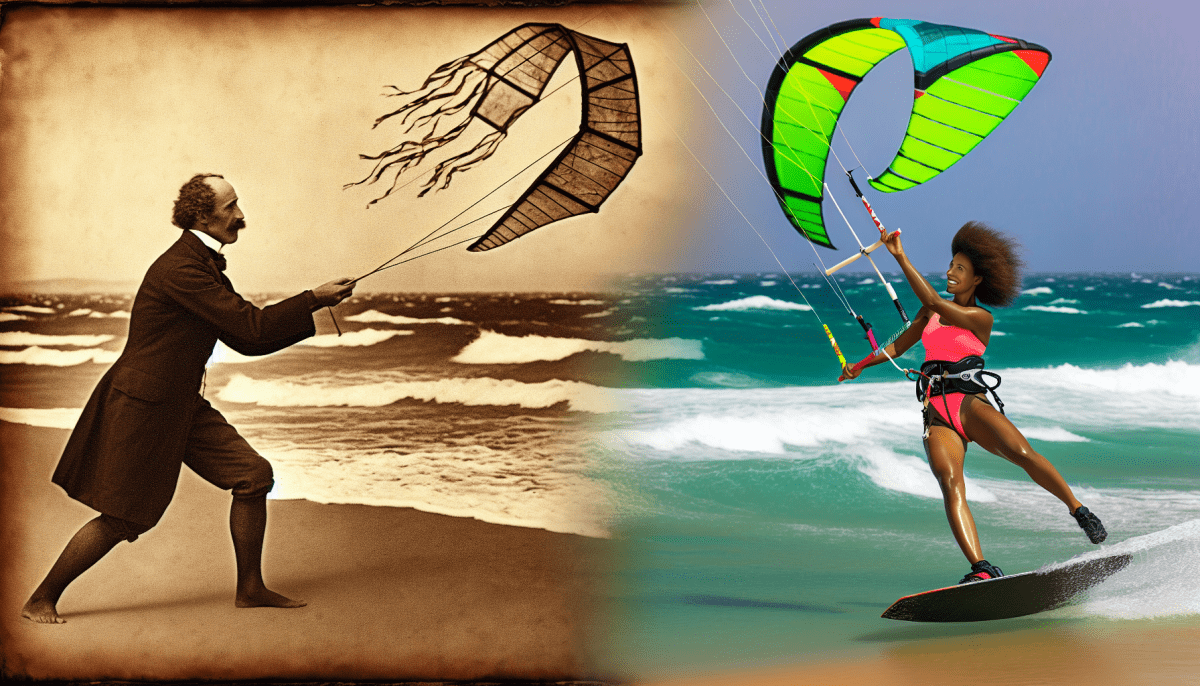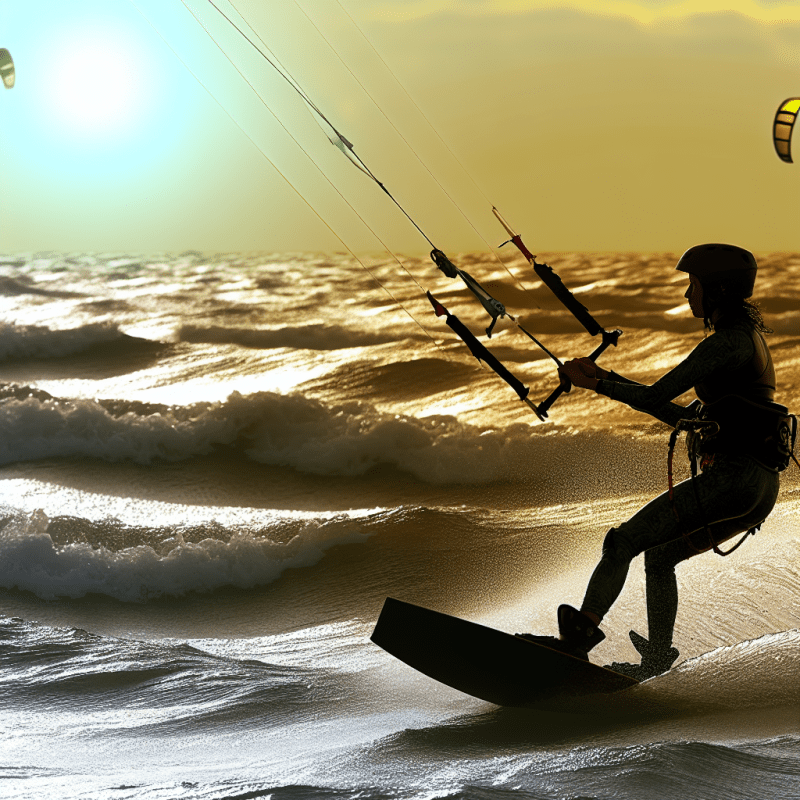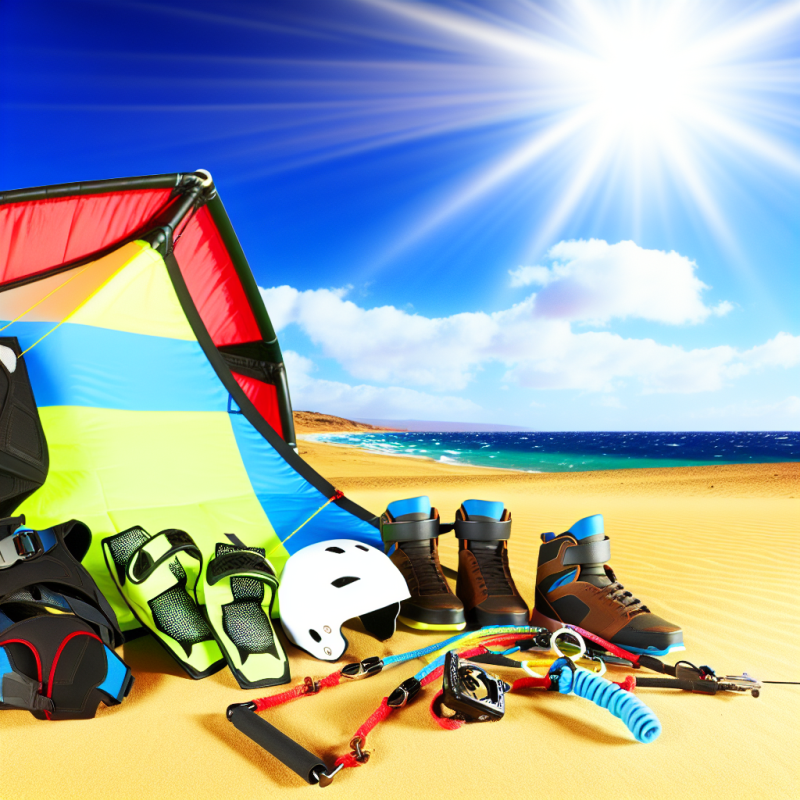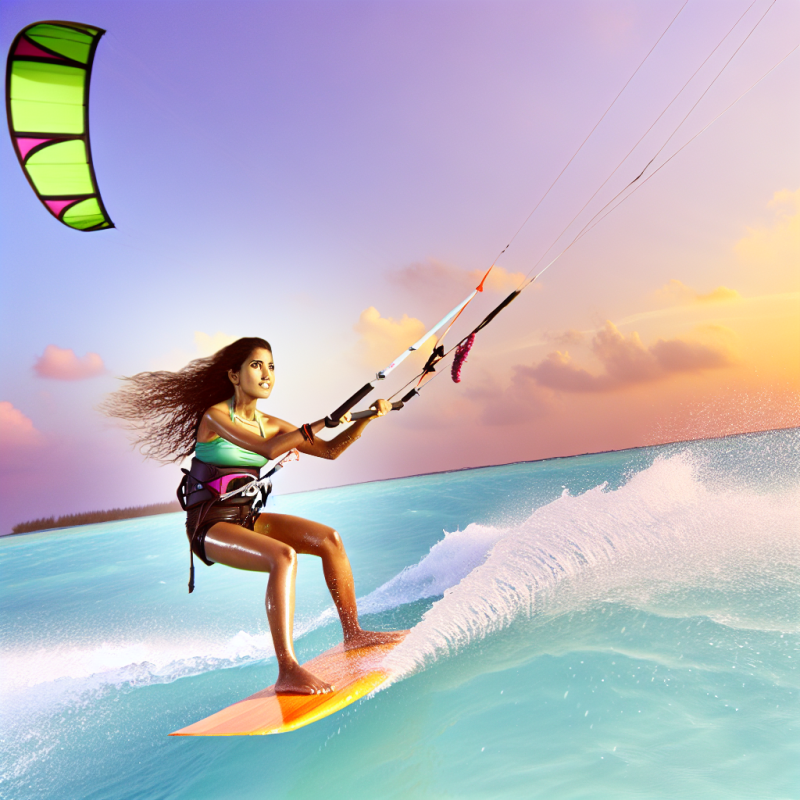Origins of Kitesurfing
The earliest references to kitesurfing are believed to go back to the 1950s when the first attempts of using a kiteboard to pull a surfer on a surfboard were achieved. This method initially started using a parachute-style kite by early kitesurfing pioneers.
Kitesurfing began to gain a wider following after it was featured in the pages of magazines and in televised events such as the Mistral World Championships in France, and later the Professional Kitesurfing Association (PKA) tour.
In the early 2000s, the development of kitesurfing was greatly connected to the modern sport, with influential figures such as Manu Bertin and Neil Hutchinson, setting the development of kitesurfing and pushing the limits of performance.
Today, kitesurfing has become one of the most popular watersports in the world with competitions and events held all over the world, and a large community of kitesurfers.
Early Kitesurfing Pioneers
In the late 1980s, a few brave adventurers began experimenting with what would eventually become kitesurfing. Among the early pioneers of the sport were MIT student Alan Spillane, power kite enthusiast and engineer Raphaël Salles, and windsurfing enthusiast Manu Bertin.
Spillane was a lover of the great outdoors who wanted to combine his passion for the water with his love of the wind. He began experimenting with starting windsurfing boards with kites in 1988, leading to the construction of the first "kiteboard."
At the same time, kite enthusiast Salles and windsurfing enthusiast Bertin considered the idea of combining their passions. The two, who were inspired by Spillane's work, joined forces to design and create what became the first commercially produced kitesurfing board in 1990.
Although these pioneers started the sport and developed a product that people could buy, they didn't name it "kitesurfing." It wasn't until 1994 that the sport was given its name, and it isn't until today that it is widely recognized.
Development of Kitesurfing Equipment
Kitesurfing equipment has been developed over the last few decades. Kitesurfing was first developed in 1984, when a French kitesurfer, Bruno Legaignoux, developed the “parafoil” kite, or a parachute kite as it is now known. This kite was designed to be lightweight, easy to use, and allowed kite surfers to stay within the air stream longer than other kites.
The next major development in kitesurfing came in the early 1990s when the “Bow” kite was invented by Line Rietveld and Wolfgang Schelp and patented in the United Kingdom. This kite design was more intuitive to use due to its curved shape and had major improvements in performance compared to the Parafoil kites of the period.
In 2002, a new type of kite, the inflatable traction kite, was developed by a company called “Ozone” in France. This kite was much larger and featured a simple bridle system and a new type of trailing edge that allowed for better control and increased safety features.
New materials and design features have recently been introduced to the sport, such as 4-line wings and 4- or 5-strut frames. These designs have allowed for faster, more aggressive riding and bigger jumps. Kitesurfing gear has been improved to the point that some riders are now able to reach speeds of over 50 mph with their strongest kite designs.
With the advances in kitesurfing equipment over the years, the sport has become safer and more accessible - allowing more people to experience the rush of kiteboarding.
Rise of Kitesurfing Competitions
Kitesurfing quickly became popular in the late 90s and the competitions began shortly after in the early 2000s. The first competition, which has now become one of the most important in the kitesurfing world, was the Red Bull King of the Air, which was held in South Africa in 2001. The event was a huge success and created more interest in the sport, gaining worldwide attention. The rules for kitesurfing competitions were established soon after, and the first professional kitesurfing association, the Kiteboarding Class Association, was created in 2002.
The Kiteboarding Class Association (KBA) created a system of star ratings and pro-level competitions that reward the best kiteboarders in the world. Since its inception, the KBA has organized World Championship events in a variety of locations, with many competitions taking place around the world every year. The World Cup Tour (WCT) allows kitesurfers to compete in various locations around the world, and has become the most prestigious competition in the sport. Other well-known competitions include the PKRA (Professional Kite Riders Association) series, now called the GKA (Globle Kitesurfing Association), and the Kiteboarding World Series.
With the increasing popularity of kitesurfing, it is no wonder why the competitions have become so popular. Kitesurfing is an exciting sport, and watching the professionals at various competitions is an inspiring experience. The sport is still evolving, and continues to offer new challenges to its competitors.
Social and Cultural Impact of Kitesurfing
Kitesurfing has made its mark on not only the watersport industry but also on social and cultural norms. It has become increasingly popular with young people and has also gained recognition in art and fashion as a lifestyle hobby. Kitesurfing has created a strong sense of community among enthusiasts, with people from diverse backgrounds and of all ages coming together to enjoy their sport.
Kitesurfing has also had a profound impact on environmental conservation, as those who participate in the sport become increasingly aware of their environment, finding ways to protect their waters and the ocean. Beyond this, the sport is also becoming a platform for some philanthropic causes to make a difference in our society, such as raising awareness and funds to preserve wildlife.
Kitesurfing also has strong ties to fashion, a culture that has been traditionally male-dominated. It has become a tool for expressing creativity and personal style for individuals of all genders. As kitesurfing continues to spread, the message of inclusivity is becoming louder and more powerful. The sport provides young people with the opportunity to branch out, take risks, and grow to their full potential.
Kitesurfing has proven to be a unifying hobby for people around the globe, as evidenced by its increasing popularity. Through its strong social and cultural ties, the sport is changing the way we view watersports and providing an outlet for those looking to take on new thrills.
Kitesurfing in Popular Media
Kitesurfing, although relatively new to the world of watersports, has already garnered plenty of attention from the media. It has been featured on numerous television shows and films, often as a thrilling and daring stunt. It has also been promoted in various advertising campaigns for various brands.
In the United States, kitesurfing had its first major media airtime in an episode of "The Real World New Orleans" in 2005. Then, in 2010, the stunt was featured in an an Emmy-winning episode of "How It's Made" on the Discovery Channel, which showed the kitesurfing equipment being created and detailed the sport.
Kitesurfing has also been seen on the big screen. In 2015, the film "Avengers: Age of Ultron" featured a chase scene with a kitesurfer gliding across a lake. Earlier, in 2008, the French film "The Swiss Family Robinson" also had a kitesurfing scene.
Kitesurfing is a popular fashion choice among celebrities. The likes of Liam Hemsworth and Harry Styles have been photographed donning minimalist kitesurfing gear. In 2018, Louis Vuitton showed a kitesurfing-inspired clothing line on the runway.
Kitesurfing is perceived today to be an exciting and fashion-forward sport, thanks to its promotion in the media. It continues to gain popularity and visibility as a sport, with more and more people taking it up to experience the thrill of gliding through the air.
Kitesurfing’s Place in the Modern World
Kitesurfing is an incredibly popular sport, with the number of people taking part having grown exponentially in the past few years. The increased accessibility of the sport has largely been thanks to improved safety measures and kitesurfing equipment. With people from all over the world taking up the pursuit, kitesurfing is becoming an increasingly international activity, with a large and diverse following.
Kitesurfing can be broken down into four primary disciplines: wave riding, freestyle, racing, and big air. Wave riding involves riding the waves of the ocean on a surfboard, utilizing the wind and the kite for speed and height. Freestyle mostly consists of tricks and big aerial jumps. Racing is, as the name implies, focused on speed, and big air takes the manueverability of the kite to the extreme with high jumps and controlled flight.
Kitesurfing has quickly gained a large following in the world of extreme sports, with many kitesurfing events and competitions being held around the world. The popularity of the sport has led to production of specialized kitesurfing equipment, such as hydrofoils and inflatable kites, which has greatly increased the safety of the sport and made it more accessible to beginner and intermediate kitesurfers.
Kitesurfing is here to stay, with the sport continually growing and evolving as time goes on. It is a sport for all, with the various disciplines catering to all sorts of abilities. From casual participants who just want to enjoy the natural beauty of the ocean and the thrill of the wind, to experienced professionals vying for world honors, kitesurfing is a unique sport that has a place in the modern world.
Conclusion
Kitesurfing, a fast-growing sport, is a relatively new activity, having only been around since the early 1990s. It has evolved rapidly over the years, becoming increasingly popular among thrill seekers, adventure lovers, and aspiring athletes. Kitesurfers can be found performing aerial stunts, riding on waves, and performing rad tricks off kickers and sliders all over the world. With new safety equipment, the ability to buy and rent quality gear, and lessons available at most beaches, the opportunities to try and explore kitesurfing are accessible to everyone.
Kitesurfing is a thrilling, growing sport with no end in sight. Whether you're a novice or an expert, it encourages exploration and creativity so don’t be afraid to fly your kite and see what it can do!



